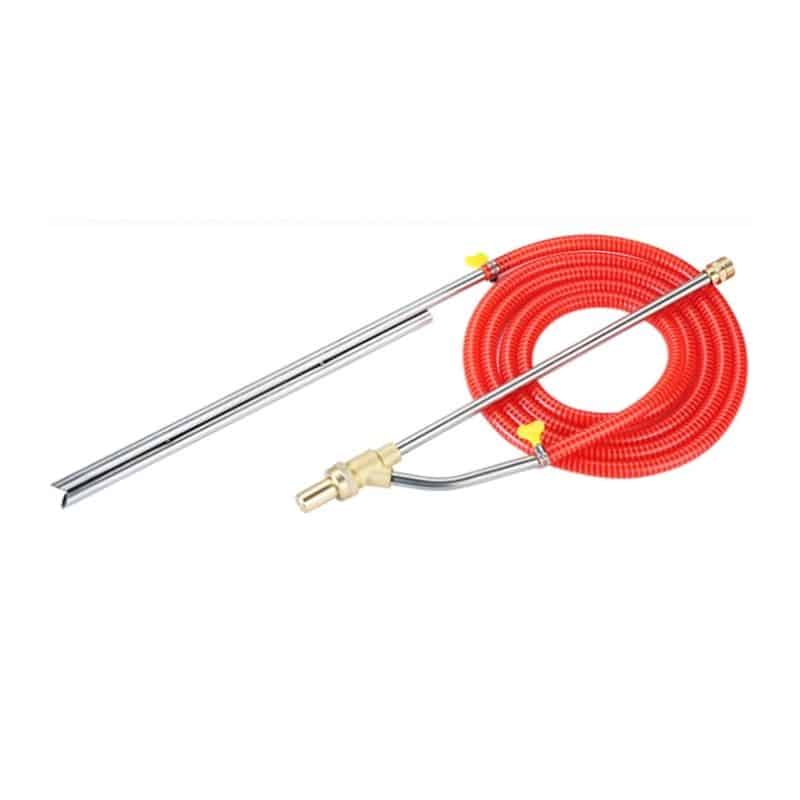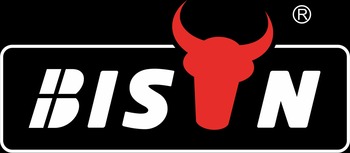Best Pressure washer sandblasting Kit
Pressure washer sandblasting kit is suction-fed injection of sand into water system, works for abrasive cleaning. Ideal for abrasive cleaning, such as removing rust, paint, graffiti, baked on grease. BISON Wet Sandblaster combined with the pressure washer and injects the sands into the water jetting to aid in blasting off coatings from the steel and concret surface, can be used on rust, pain, stains and graffiti removing.
Bison Machinery is one of the leading manufacture of pressure washer, sewer /drain jetting machine, high pressure pump and functional pressure washer accessories, with CE, Rohs, Euro5 certificated and patents more than 30. All metal parts are processed by precision processing equipment, and each one will be 100% inspected before leaving the factory.
Contact BISON immediately to send a wholesale request. We will help you choose the best power washer surface cleane according to your needs. In addition, we also provide pictures, PDFs, videos, etc. to help you expand your business.
Pressure Washer Wet Sand Blasting Attachment by BISON
* Premium material for durability and excellent performance.
* Steel or Ceramic Nozzles are suitable for light-duty work or infrequent users.
* Great for Removing Rust or Paint from Metal, Concrete.

Hobby Pressure Washer Sandblaster 2600PSI(SB-01)
| Stainless Steel Lance Length: | 18"/46cm |
| Transparent Hose Length: | 3m |
| Adapter: | Optional |
| Max Pressure: | 180bar/ 2600psi |
| Max Temperature: | 60°C/140°F |

2500PSI Pressure Washer Sandblasting Kit(SBK-01)
| Stainless Steel Lance Length: | 18"/46cm |
| Transparent Hose Length: | 3m |
| Adapter: | Optional |
| Max Pressure: | 180bar/ 2600psi |
| Max Temperature: | 60°C/140°F |

18FT Commercial Using Brass Wet Sandblaster 4000PSI 10GPM(SB-02)
| Stainless Steel Lance Length: | 52cm |
| Siphon Hose Length: | 3.5m |
| Connector: | Optional |
| Max Pressure: | 345bar/ 5000psi |
| Max Temperature: | 60°C/140°F |

Professional Heavy Duty 304SS Forged Wet Sandblaster(SB-03)
| Connector: | Optional |
| Max Pressure: | 550bar / 8000psi |
| Max Flow Rate: | 21gpm / 80lpm |
| Max Temperature: | 90°C/194°F |

5000PSI Wet Abrasive Sandblaster Attachment Dustless Sand Blasting Kit(SB-04)
| Stainless Steel Lance Length: | 16" |
| Siphon Hose Length: | 3meters |
| Connector: | Optional |
| Max Pressure: | 345bar/ 5000psi |
| Max Temperature: | 60°C/140°F |

1/4 Inch Quick Disconnect Wet SandBlasting Kit(SBK-04)
includes 3m hose, 16″ pressure washer wand (water input), 16″ sand wand(sand input), a goggle, 4 hose clamps, 4 ceramic nozzles, and 2 rubber bands
| Stainless Steel Lance Length: | 16" |
| Siphon Hose Length: | 3meters |
| Connector: | Optional |
| Max Pressure: | 345bar/ 5000psi |
| Max Temperature: | 60°C/140°F |
Get Best pressure washer sandblasting kit From Bison
Pressure Washer Sandblaster Buying Guide
How To Use a Pressure Washer Sandblaster?
As an expert in pressure washer manufacturing, Bison understand the need for detailed guidance when it comes to using a pressure washer sandblaster. This powerful tool can be a game-changer for your pressure washing business, but it’s essential to understand how to use it safely and effectively. Here’s a step-by-step guide to help you get started.
Preparation
Protective Gear: Always wear protective gear, including safety glasses, gloves, and a dust mask to protect against high-pressure water, sand, and debris.
Workspace: Ensure your work area is clear of unnecessary items that could become hazardous when sandblasting.
Check Equipment: Examine your pressure washer and sandblasting kit for any visible damage before use.
Connection
Attach the Sandblasting Kit: Connect the sandblasting kit to your pressure washer. This typically involves connecting the sandblasting tube to the pressure washer wand and the sand probe into the sand supply.
Nozzle Size: Use the recommended nozzle size for your specific pressure washer model. The correct nozzle size is crucial for achieving optimal sandblasting results.
Operation
Start the Pressure Washer: With everything connected, start your pressure washer according to the manufacturer’s instructions.
Begin Sandblasting: Aim the nozzle at the surface you’re cleaning and squeeze the trigger to begin sandblasting. Hold the nozzle about 8-12 inches from the surface and move it in a sweeping motion.
Completion
Turn Off Equipment: Once you’ve finished sandblasting, release the trigger, turn off the pressure washer, and disconnect the sandblasting kit.
Clean Up: Clean the equipment thoroughly after use to prevent clogging and prolong its lifespan.
By following these steps, you can safely and effectively use a pressure washer sandblaster. Remember, safety is paramount when handling high-pressure equipment. Always adhere to the dos and don’ts to ensure an efficient outcome and to avoid accidents and injuries.
Safety Tips and Warnings
- Do not point the nozzle at people or animals.
- Never operate the pressure washer without wearing appropriate safety gear.
- Ensure the san supply is kept dry to prevent clogging.
- Always follow the manufacturer’s instructions and maintenance guidelines.
Troubleshooting Pressure Washer Sandblaster Issues
As an expert in pressure washer troubleshooting, we know that the key to keeping your sandblaster attachment in top working condition is understanding how to diagnose and fix common problems. This guide will walk you through some typical issues and their solutions, as well as general maintenance tips.
Understanding Your Sandblaster Attachment
Before we dive into troubleshooting, it’s crucial to understand the main components of a sandblaster attachment:
- Sandblasting Tube: This tube connects the sand supply to your pressure washer wand.
- Sand Probe: The probe goes into your sand supply and feeds it into the sandblasting tube.
- Nozzle: The nozzle at the end of the wand is where the pressurized water and sand mixture are expelled.
Each of these components requires regular cleaning and maintenance to ensure optimal performance.
Common Problems and Solutions
Problem 1: Inconsistent Sand Flow
If you notice an inconsistent or weak sand flow, it could be due to clogging in the sandblasting tube or probe.
Solution: Disconnect the sandblasting tube and probe and clean them thoroughly. Check the sand supply to ensure it’s dry and free of debris.
Problem 2: Low Pressure
Low pressure could result from a damaged or inappropriate-sized nozzle.
Solution: Check the nozzle for any visible signs of damage. If it’s damaged or worn out, replace it with a new one. Ensure the nozzle size matches the manufacturer’s recommendation for your specific pressure washer model.
Problem 3: No Sand at All
If there’s no sand coming out from the nozzle, it could be due to a disconnected sand probe or a blocked sand supply.
Solution: Check the connection of the sand probe and ensure it’s securely placed in the sand supply. If the sand supply is wet or clumped together, dry it out and break up any clumps.
General Maintenance Tips
Regular cleaning and maintenance can prevent many common problems with your sandblaster attachment:
- Regular Cleaning: After each use, clean the sandblasting tube, probe, and nozzle to remove any residual sand and prevent clogging.
- Proper Storage: Store the attachment in a dry, clean area to prevent rust and corrosion.
- Routine Inspection: Regularly inspect the attachment for any visible signs of damage or wear and replace parts as needed.
By following this guide, you can diagnose and fix common problems with your sandblaster attachment and ensure its longevity and optimal performance. Remember, proper maintenance and understanding of your equipment are key to efficient and effective sandblasting.
Benefits and Applications of Pressure Washer Sandblasters
Pressure washing is a cleaning method that utilizes high-pressure water spray to remove dirt, grime, and other contaminants from surfaces. When combined with sandblasting, a technique that uses abrasive sand particles to clean or smooth surfaces, the result is a highly effective cleaning process that can tackle even the most stubborn stains and debris.
Advantages of Pressure Washer Sandblasters
Pressure washer sandblasters come with several key benefits:
Deep Cleaning: The combination of high-pressure water and abrasive sand provides a deep cleaning action that can effectively remove rust, paint, and stubborn grime that regular pressure washing might not be able to handle.
Versatility: Pressure washer sandblasters can be used on a variety of surfaces, including metal, concrete, brick, and wood, making them a versatile addition to any pressure washing business.
Efficiency: Sandblasting attachments can increase the efficiency of your pressure washer, allowing you to complete tough cleaning jobs faster and more effectively.
Cost-Effective: By enhancing the capabilities of your existing pressure washer, a sandblaster attachment can save you the cost of purchasing separate equipment for heavy-duty cleaning tasks.
Common Applications of Pressure Washer Sandblasters
The power and versatility of pressure washer sandblasters make them suitable for a wide range of applications:
Surface Preparation: Whether you’re preparing a surface for painting, coating, or refinishing, a pressure washer sandblaster can help create a clean and smooth canvas.
Rust Removal: Sandblasters are excellent for removing rust from metal surfaces, making them ideal for automotive and machinery cleaning.
Graffiti Removal: The abrasive action of sandblasting can effectively remove graffiti from walls and other surfaces.
Restoration Projects: From restoring old furniture to cleaning historic buildings, pressure washer sandblasters can delicately yet effectively remove layers of paint, dirt, and grime.
In conclusion, the benefits and applications of pressure washer sandblasters make them an invaluable tool for any pressure washing business owner or dealer. Their ability to deliver deep cleaning, coupled with their versatility and cost-effectiveness, makes them a worthy investment for anyone seeking to enhance their cleaning capabilities.
Bison Pressure Washer Sandblasting Features
Bison’s pressure washer sandblasting attachments are engineered to handle high pressure, transforming your regular pressure washer into a powerful sandblasting machine. Our attachments can withstand pressures up to 5000 PSI, making them suitable for a wide range of heavy-duty cleaning tasks.
Versatile Application
Our sandblasting attachments are designed to work with a variety of pressure washer models, offering a convenient plug-and-play solution. Whether you’re removing paint, rust, or stubborn grime, our sandblasting attachments are up to the task.
Durable Construction
Quality and durability are paramount in our design process. Bison’s pressure washer sandblasting attachments are built with robust materials that resist wear and tear, ensuring longevity and reliable performance.
Adjustable Sand Flow
To cater to diverse cleaning needs, our sandblasting attachments feature an adjustable sand flow mechanism. This allows you to control the intensity of the sandblasting process, giving you the flexibility to handle different surfaces and cleaning requirements.
Easy Installation
We understand that time is of the essence in any cleaning business. That’s why our sandblasting attachments are designed for easy installation, allowing you to set up quickly and get on with the task at hand.
Sandblaster FAQs
Q:What Kind Of Sand Do You Use For Wet Sandblasting?
A: Silica sand, baking soda or washed and dried river sand.
Q: What's The Application Of Wet Sandblaster?
A: Pressure washer sandblaster kit works for abrasive cleaning. Great for removing rust, graffiti, paint, baked on grease.
CONTACT US TO KNOW MORE BISON PRESSURE WASHER

